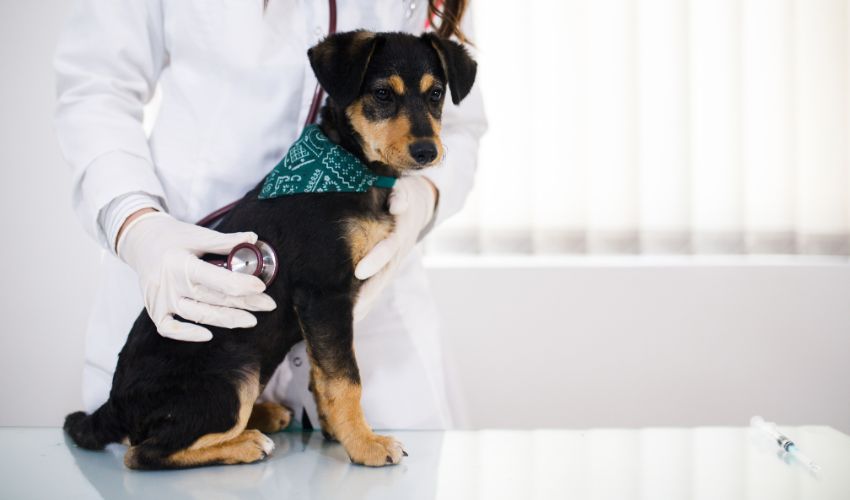As responsible fur parents, knowing the stages of parvo dog sickness can help them detect this potentially deadly disease early on. Fortunately, vaccinations are available to help prevent canines from getting infected by parvovirus.
Parvovirus is a highly contagious virus that concerns all dogs. However, unvaccinated canines and pups younger than four months old are the most at stake. Learn more about the four stages of this disease below.
6 Stages Of Parvo In Dogs
Even though parvo can have a high survival rate if treated aggressively, detecting and preventing them in its early stages is still better. Worry less because this article discusses the phases of the most viral infection in dogs.
Stage 1: Infection
Adult and young dogs can get infected through viral particles, such as fecal material, from a parvo-infected dog. It can also come from a few places, including the following:
- The mother dog
- Dog sniffing a parvo-infected canine’s butt or ingesting its saliva
- On the ground, surface, or the overall environment
- Objects that came into contact with the infected dog’s feces
Keep in mind that even a minimal amount of fecal material can cause this infection. Moreover, it enters through the pup’s mouth.
Stage 2: Incubation
It is impossible to spot whether the canine has parvo early because the virus incubation is three to seven days after its first contract. In addition, dogs may not yet show any manifestations.
During the incubation period, the parvo craves the most rapidly dividing cells in the dog’s body. They typically start attacking the lymph nodes or tonsils. Targeting these cells allows the virus to multiply efficiently and effectively to invade the host’s system further.
Once the virus has reproduced and entered the dog’s bloodstream, it will start seeking out other rapidly dividing cell sources, such as bone marrow and those in the walls of the small intestines.
Further, parvo in small pups infects the heart, causing poor heart function, inflammation of the heart muscle, and arrhythmias.
Stage 3: Emergence of Parvo Virus Symptoms
After five to eight days after the dog’s first exposure to the virus, the manifestations begin to appear. It may include the following:
- Fever
- Vomiting
- Watery or bloody diarrhea, or both
- Lethargy
- Bloated painful abdomen
- Loss of appetite
- Low body temperature
Stage 4: Parvo Diagnosis
When the parvo infects the dog’s bone marrow, it strikes the young immune cells, decreasing their protective white blood cells. Further, it results in their body’s ability to protect itself and let the infection quickly invade the gastrointestinal tract.
Once the virus starts attacking the pup’s small intestine, it prevents their ability to absorb nutrients, prevents bacteria from moving into their gut, and prevents fluid loss in their stool.
While parvo is not always lethal, some cannot survive the disease despite getting a dog parvo medicine due to shock and severe dehydration. This is why frequent vet visits are required once the vet detects parvo on dogs.
Stage 5: Parvo Treatment

When caught and treated early enough, dogs can quickly recover at home with a dog parvo vaccine and a few prescriptions from their vet. They often start the treatment by ensuring the canines get rehydrated again.
Vets will try to counter the loss of the dog’s liquids due to diarrhea and vomiting through IV fluids. They will then follow it by administering the appropriate antibiotics, vitamins, anti-inflammatories, and antispasmodics.
Supportive care for parvo dog sickness typically includes the following:
- Correction of the dog’s electrolyte imbalances or lower blood glucose
- Hospitalization with intravenous liquids
- Focusing on the dog patient’s nutrition using a feeding tube if necessary
- Taking antiemetics to control vomiting
However, in some severe parvo cases, vets could require a series of blood transfusions as part of the dog’s aggressive treatment method.
Stage 6: Dog’s Recovery
After performing the necessary treatment plans, parvo puppies can recover anytime between twelve and twenty days. This is true for indoor and outdoor younger and older dogs.
Pet owners must take caution and keep their recovered dogs isolated from other dogs. In addition, it would be an excellent idea to disinfect anything the pup touches or uses, especially the room they are staying in.
Most importantly, while they are in recovery, it is their guardians’ responsibility to ensure they are eating and drinking on a strict regular schedule. Lastly, a bland diet is best for the first week of recovery.
Conclusion
Knowing that getting parvo dog sickness is common, and prevention is better than cure. Canine pet owners must see a vet at the first sign that something unusual is happening to their pups. Aside from that, being responsible for dog ownership is part of getting familiar with various diseases that could affect their pets.
For more informational blogs regarding dog diseases, make sure to visit Doobert. We are advocating for making the planet a better place for animals. If you share the same sentiments, connect with us and be part of our growing community!











